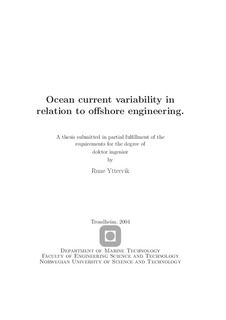| dc.description.abstract | This work adresses ocean current variability in relation to offshore engineering.
The offshore oil and gas activity has up until recently taken place mainly on the continental shelves around the world. During the last few years, however, the industry has moved past the continental shelf edge and down the continental slope towards increasingly deeper waters. In deep water locations, marine structures may span large spaces, marine operations may become more complicated and require longer time for completion and the effect of the surface waves is diminished. Therefore, the spatial and temporal variability of the current is expected to become more important in design and planning than before.
The flow of water in the oceans of the world takes place on a wide variety of spatial scales, from the main forms of the global ocean circulation (~km), to the microstructure (~mm) of boundary layer turbulence. Similarly, the temporal variability is also large. In one end of the scale we find variations that take place over several decades, and in the other end we find small-scale turbulence (~seconds). Different features of the flow are driven by different mechanisms. Several processes and properties (stratification1, sloping boundary, Coriolis effect, friction, internal waves, etc.) interact on the continental slope to create a highly variable flow environment. Analysis of a set of observed data that were recorded close to the seabed on the continental slope west of Norway are presented. The data suggest that some strong and abrupt current events (changes in flow speed of ~0.4 m/s in just a couple of hours) were caused by motions of the deep pycnocline2, driven by variations in the surface wind field. This conjecture is partly supported by numerical simulations of an idealised continental slope and a two-layer ocean. The data also contains an event during which the flow direction at the sea bed changed very rapidly (within a few minutes) from down-slope to up-slope flow. The change in speed during this event was as high as 0.5 m/s.
Another data set has been analyzed in order to illustrate the spatial variation in the current that can sometimes be found. It is shown that the flow in the upper layer is virtually decoupled from the flow in the lower layer at a location west of Norway. This is either caused by bottom topography, stratification or both.
High variability of the current presents new requirements to the way that the current should be modelled by the offshore engineer. For instance, it is necessary to consider which type of operation/structure that is to be carried out or installed before selecting design current conditions. Reliable methods for obtaining design current conditions for a given deep water location have yet to be developed, only a brief discussion of this topic is given herein.
It is shown, through calculations of VIV-response and simulations of typical marine operations, that the variability of the current will sometimes have a significant effect on the response/operation.
1Vertical distribution of density. In a stratified ocean or flow, the density of the water varies in the vertical direction.
2pycnocline=density surface between water masses. The pycnocline between two water masses of different density is defined by the maximum of the density gradient. | nb_NO |
